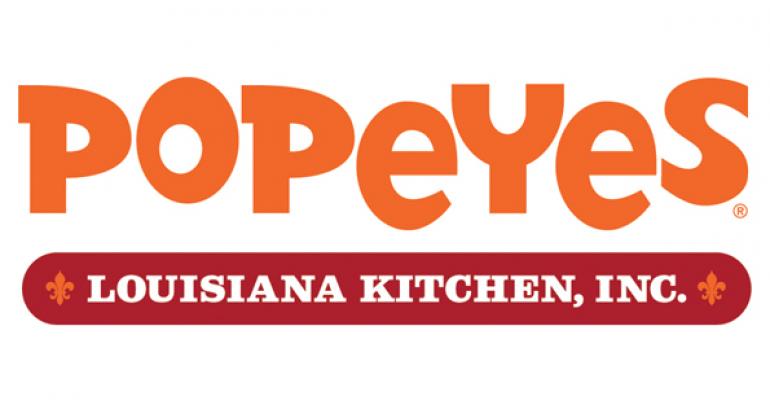Popeyes Louisiana Kitchen Inc.’s same-store sales improvement has given the brand opportunities to build on that success and made it one of the better performing restaurant stocks on Wall Street.
The Atlanta-based quick-service operator reported this week that its U.S. same-store sales rose 7.2 percent during the third quarter ended Oct. 5, the 26th straight reporting period in which Popeyes outperformed its quick-service chicken peers, and the 12th straight quarter it outdid the quick-service sector as a whole.
With those results, the chain is gaining access to better locations while improving franchisees’ financial wherewithal to remodel units, yielding additional sales.
“There’s no question that success in our brand and our restaurant performance has fueled continued success,” Popeyes CEO Cheryl Bachelder told Nation’s Restaurant News Thursday. “In our business, the success of the sales of your units, the success of your service to guests and the success of franchisees, if you get that all moving in the right direction,” your brand will succeed.
Popeyes’ stock has risen more than 8 percent today, and has increased 36 percent on the year.
Overall, the third quarter was a good one for many restaurant companies. Various sales indexes have indicated that the quarter was the industry’s best in more than two years.
On a two-year basis, Popeyes’ same-store sales rose 12.3 percent. Bachelder said that the improving consumer economy, coupled with lower gas prices, provided “a little more tailwind” during the period.
But she also noted that the company’s share of the quick-service chicken segment has accelerated even in that improved economy. Popeyes’ market share is now 23.7 percent, an increase from from 21.2 percent during the period a year ago. The market-share gain isn’t just from same-store sales: Popeyes opened 44 net new restaurants during the third quarter and expects to finish the year with 100 to 130 more locations. Popeyes now has 2,315 restaurants worldwide.
The company has the potential to keep adding to its market share. Jefferies analyst Alexander Slagle said in a note today that Popeyes’ development potential “is among the strongest in the category,” with the ability to double or triple its unit base in the U.S.
Popeyes is building locations on better sites in markets very familiar with the brand. New locations average first-year sales of $1.6 million, compared with an average $1.3 million for the system as a whole. Improving site selection and the company’s brand-building effort has yielded higher sales, Bachelder said.
The company’s brand-building effort includes a successful national television ad campaign featuring its “Annie” spokeswoman, amplifying enthusiasm for new locations long before they open.
“Today, when we open a Popeyes in a new location, we get people who say they’ve been waiting six years for us to come to their town,” Bachelder said.
Record remodeling program
(Continued from page 1)
The sales and market share improvement is also fueling franchisee profits. The company’s freestanding franchisees had operating profits of 22.9 percent in the second quarter of this year, compared with 22 percent the year before, an increase of about $12,000 per restaurant, Bachelder said. In 2008, operators’ profits were 17 percent, she said.
Franchisees who are more profitable do two things: Build new units and remodel existing locations, Bachelder said. Existing franchisees are building 90 percent of new units, which she said is a statement that operators believe in the brand.
Franchisees are also remodeling at a fast clip. The company kicked off a remodeling program two years ago, and nearly 80 percent of the chain’s restaurants are now upgraded. Bachelder expects the company to complete that effort next year.
“It’s the fastest remodel I’ve seen in my career,” Bachelder said. “Most systems take five to seven years to remodel. But that means they’re almost in a constant remodeling stage. We worked very closely with our franchisees. We wouldn’t remodel the system until sales were stronger, and so were their cash flows. We waited to remodel the system until 2012. By then, franchisees were in their third or fourth year of good comps and cash flow. They were ready to go and ready to go fast.”
Remodeling costs about $120,000 per unit, and in the program’s early stages improved a restaurant’s sales by 3 percent to 4 percent, though the company no longer reports that figure. “It’s definitely had a positive impact on sales,” Bachelder said.
The company has also been able to ensure that its products are both innovative and value-oriented, without sacrificing either, Bachelder said. In August, the company offered for a limited time Tear’n Tenderloin, two chicken tenderloins served with Cajun fries and a biscuit, priced at $3.99. In September, it offered a value meal with two pieces of chicken or three tenders and two choices of sides, priced at $5.
“Our culinary team is amazing at this particular thing,” Bachelder said. “They innovate and they don’t bring us crazy expensive ideas that are too hard or too high cost. Everything they put into consumer testing can be sold at (profitable) food costs, or it doesn’t make the cut.”
Contact Jonathan Maze at [email protected].
Follow him on Twitter: @jonathanmaze





